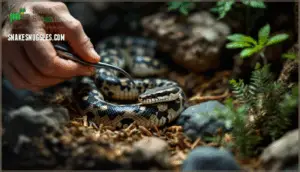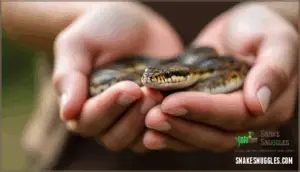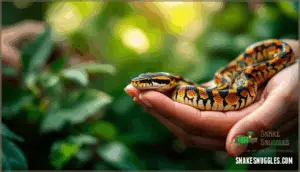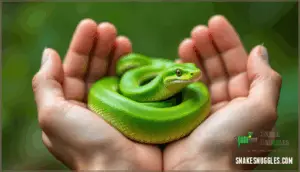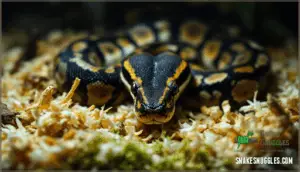This site is supported by our readers. We may earn a commission, at no cost to you, if you purchase through links.
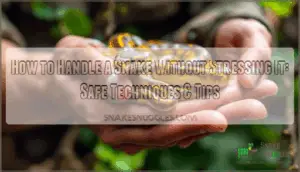
Snakes communicate discomfort through subtle body language shifts that humans often miss until defensive behaviors like hissing or striking appear. Learning to read these signals transforms interaction from a stressful event into a trust-building routine.
The difference lies in understanding what your snake needs before, during, and after each interaction, from proper hand placement to recognizing when it’s time to back off.
Table Of Contents
- Key Takeaways
- Pre-Handling Essentials for Stress-Free Snake Care
- Safe Techniques to Pick Up a Snake
- Best Practices During Snake Handling
- Recognizing and Responding to Snake Stress
- Post-Handling Steps for Snake Well-being
- Species-Specific Handling: Corn Snake Tips
- Frequently Asked Questions (FAQs)
- How to handle snakes safely?
- How do you handle a stressed snake?
- Do Snakes get stressed when handled?
- How to handle a pet snake?
- How to reduce stress in snakes?
- Should you handle a snake without turning on the water?
- Could you handle ALL snakes even if you follow these rules?
- What do you do when a snake poops? Do you clean it right away?
- Can someone handle a viper?
- Does handling snakes stress them out?
- Conclusion
Key Takeaways
- Snakes communicate stress through subtle body language like muscle tension, coiling, hissing, and tail rattling—signals that appear before defensive strikes and require immediate response to prevent escalation.
- Proper handling technique centers on supporting the snake’s mid-body from the side with both hands, avoiding head and tail contact while moving slowly to prevent triggering fear responses that mimic predator attacks.
- Pre-handling preparation matters as much as technique itself—washing hands prevents feeding responses, creating quiet environments reduces stress triggers, and waiting 48 hours after feeding prevents regurgitation.
- Species-specific approaches improve outcomes significantly, with corn snakes requiring two-week acclimation periods, five-minute initial sessions, and recognition that 85% perform defensive tail rattling when startled despite their beginner-friendly reputation.
Pre-Handling Essentials for Stress-Free Snake Care
Before you reach into your snake’s enclosure, you need to set the stage for a calm, safe interaction. Think of it as creating a peaceful meeting space where both you and your snake feel comfortable.
These few preparatory steps will help prevent stress responses and keep interaction sessions positive for everyone involved.
Hand Washing and Hygiene Protocols
Before you even think about reaching for your snake, washing your hands isn’t just good manners—it’s essential for preventing a feeding response and keeping both you and your pet safe from harmful bacteria. Caretaker hygiene protects against zoonotic diseases like Salmonella, which snakes commonly carry.
Here’s your pre-touching protocol:
- Wash your hands thoroughly with antibacterial soap for at least 20 seconds before touching.
- Use safe products to disinfect enclosures and equipment weekly to prevent disease transmission.
- Avoid touching your face during snake care to reduce Salmonella prevention risks.
- Wash your hands again immediately after touching to protect your snake’s health and wellbeing.
This simple routine makes for safer reptile care for everyone involved.
Setting Up a Calm Environment
Your snake’s environment sets the stage for a successful interaction session, so you’ll want to make sure the room is quiet, calm, and free from sudden noises or movements that might startle your pet. Think of it like creating a spa day—dim the lights to reduce stress, remove other pets from the area, and check that the enclosure is secure before you begin.
| Environmental Factor | Stress Reduction Tip |
|---|---|
| Quiet surroundings | Turn off TVs, music, and close doors to prevent sudden sounds |
| Dim lighting | Use soft, indirect light rather than harsh overhead bulbs |
| Minimal vibrations | Choose a stable surface away from foot traffic or appliances |
These small adjustments make your snake enclosure a calm starting point for secure interaction.
Interpreting Snake Body Language
Once you’ve set the scene, reading your snake’s body language becomes the next skill that’ll keep both of you comfortable and safe. Behavioral patterns reveal whether your snake is ready for interaction or needs space. Watch for these cues:
- Tongue flicking means your snake is alert and exploring its surroundings—a calm indicator
- Coiled posture with retracted head signals defensive behavior and threat signals
- Hissing warns you to stop immediately
- Tail rattling shows your snake feels cornered
- Relaxed movement indicates comfort
These reading cues guide your interaction adjustments, helping you respond appropriately to snake body language interpretation rather than guessing what your pet needs.
Ideal Temperature and Lighting Conditions
Just like you wouldn’t take a walk outside in the dead of winter without a coat, your snake won’t be comfortable interacting if the room temperature drops too low. Keep the interaction area between 70-75°F to maintain your snake’s comfort and support snake health and wellbeing.
Environmental factors like temperature gradient affect how your snake responds—cooler temperatures can make them sluggish or defensive, while proper warmth helps them stay relaxed during interaction.
Removing Other Pets and Distractions
Before you even think about opening your snake’s enclosure, make sure the coast is clear—dogs, cats, and other curious pets need to be in a different room entirely. Here’s why Pet Safety and Noise Reduction matter for snake interaction safety:
- Predator scent from other animals triggers defensive snake behavior
- Sudden barking or movement creates environmental factors that stress your snake
- Visual Barriers help prevent your snake from seeing potential threats
- Scent Management reduces feed response confusion
- Child Supervision prevents unexpected interactions that compromise secure interaction
Safe Techniques to Pick Up a Snake
Picking up your snake the right way makes all the difference between a calm interaction and a stressful one. The key is to move slowly, support the snake’s body properly, and avoid triggering defensive instincts.
Let’s walk through the safest techniques to lift your snake without causing unnecessary stress.
Approaching The Enclosure Calmly
When you move toward your snake’s home too quickly, you’re basically announcing yourself like a hawk swooping in from above—and no snake wants that kind of surprise. Instead, slow your approach and keep the environment quiet. This gives your snake time to register visual cues without triggering a defensive response.
Respecting its territory through careful, deliberate movements is fundamental to snake safety and helps you read snake behavior before you even open the enclosure.
Using a Snake Hook or Tools
A snake hook isn’t just for experienced keepers—it’s actually one of the safest ways to let your snake know you’re not food before your hands ever get close. Gently tap or stroke your snake’s mid-body with the hook to wake it and signal your presence.
This simple tool reduces stress and prevents accidental bites by eliminating the surprise factor, making secure interaction techniques easier for everyone involved.
Proper Hand Placement and Support
Once you’ve signaled your approach with a hook, the next move—where you place your hands—can make the difference between a confident snake and one that feels like it’s being grabbed by a hawk.
Reach from the side and scoop under the mid-body, supporting as much length as possible for even distribution. This secure hold prevents the snake from feeling dangled or trapped, allowing gentle guidance while you’re interacting with a snake calmly and safely.
Avoiding The Head and Tail
Grabbing the head feels like control, but to your snake, it’s pure panic—and snatching the tail leaves the heavy body unsupported, turning a calm moment into a thrashing scramble.
Head restraint risks triggering defensive strikes, while tail autonomy defense can cause your snake to twist violently.
Instead, focus on gentle body support across multiple balance points, using controlled movement guide techniques that distribute weight evenly and keep both you and your snake calm during proper care.
Best Practices During Snake Handling
Once you’ve got your snake in hand, the way you move and position yourself makes all the difference in keeping things calm and safe. Your holding technique directly impacts how relaxed your snake stays and whether you can prevent accidents or escapes.
Let’s walk through the key practices that’ll help you maintain control while giving your snake a stress-free experience.
Controlled, Gentle Movements
Your hands are the steering wheel—smooth, steady adjustments keep your snake feeling secure, while jerky movements can trigger a defensive reaction faster than you’d expect. Think of it like this: you’re guiding, not grabbing. Slow motions and even support along the body prevent stress, while fluidity in your care techniques helps your snake feel less like prey and more like an explorer.
- Shift your hands gently beneath the snake’s body as it moves, avoiding sudden lifts or drops.
- Let the snake weave through your fingers naturally instead of restricting its path.
- Keep your grip relaxed—avoid squeezing, which signals danger to the snake.
- Move your arms smoothly when repositioning, not in quick, unpredictable jerks.
- Maintain consistent contact so the snake doesn’t feel like it’s falling or floating unsupported.
Staying Seated and Maintaining Control
Sitting down isn’t just about comfort—it’s your safest bet for keeping both you and your snake secure if something unexpected happens. Seated stability gives you a controlled grip and better posture, reducing the risk of drops if your snake suddenly moves.
This care technique keeps your core engaged and your reactions measured, so secure care becomes second nature. When you’re grounded, interacting with a snake feels less unpredictable, and snake safety improves dramatically.
Preventing Escapes and Accidents
Snakes are natural explorers and escape artists, so keeping them away from furniture gaps, electrical cords, and other hazards requires constant awareness during every interaction. Your interaction environment should feel like a controlled zone where secure interaction becomes automatic.
- Close doors and windows to prevent your snake from accessing unsafe areas outside the enclosure.
- Clear surfaces of small objects that could trigger a feed response or cause a snake bite incident.
- Check enclosure security before and after interaction to be certain latches work properly.
- Keep emergency protocols ready, including contact information for exotic vets and child safety measures if kids are present.
Creating Safe Enrichment Spaces
Beyond securing the space itself, providing enrichment opportunities lets your snake engage its natural curiosity in ways that reduce stress and make interaction sessions more rewarding for both of you.
Set up a dedicated enrichment space with climbing options like branches, hiding spots for security, and a safe substrate. Maintain a temperature gradient so your snake can thermoregulate comfortably outside its enclosure, promoting animal welfare and secure snake interaction.
Recognizing and Responding to Snake Stress
Reading your snake’s stress signals is like learning a new language—one that could prevent a bite or keep your pet comfortable. Snakes communicate discomfort through specific body movements, defensive behaviors, and physical changes that you need to recognize quickly.
Let’s break down the warning signs and what to do when your snake tells you it needs a break.
Body Language Signs of Stress
When your snake’s body goes rigid or coils tight, it’s telling you something important. Defensive postures like raised heads, flattened necks, or body arching signal acute stress.
Watch for changes in movement too—hyperactivity, freezing in place, or frantic escape attempts all indicate discomfort. Tongue flicking patterns shift during stress; erratic flicking or complete cessation means your snake isn’t comfortable.
Hissing, mock striking, and rapid breathing are clear warnings to back off immediately. Snakes may also exhibit signs of severe stress, such as striking at stimuli.
Behavioral Changes During Handling
During interaction, observe how your snake’s defensive behaviors evolve—this is when stress indicators become most visible. Research shows that 60% of snakes display tail rattling within three minutes of capture, while hissing occurs in 54% of individuals during initial interactions. As the interaction continues, a reduction in exploratory behavior becomes apparent; snakes spend more time motionless or hiding afterward, averaging 13.6% of their time in hideboxes post-interaction. Age differences also play a role—adults exhibit much higher defensive responses than juveniles during snake behavior and interaction sessions. It’s crucial to consider how genetic factors can influence these behaviors.
Key behavioral shifts to monitor:
- Increased tail rattling or mock striking as interaction progresses
- Freezing behavior replacing normal exploratory movement
- Escalating hissing frequency beyond initial warnings
- Musking or defecating indicating heightened threat perception
- Reduced tongue flicking or erratic patterns signaling discomfort
Interaction habituation reduces these responses over time, but initial sessions reveal your snake’s true stress threshold.
Physical Indicators of Discomfort
While behavioral shifts reveal stress through action, your snake’s body will telegraph discomfort through physical changes you can see and feel during each interaction. A coiled neck with retracted head signals defensive snakes preparing to strike. Tail shaking mimics rattlesnake warnings, while hissing sounds accompany these snake defensive behaviors.
Musking or defecating represents peak stress—your snake’s last-resort defense mechanism. Watch for muscle tension, rigid posture, and attempts to escape your grasp, as body language always precedes escalation.
When to Pause or End Handling
The moment you notice any of these stress signals, it’s time to call it quits—forcing interaction only teaches your snake to fear interaction instead of tolerating it.
Respect interaction limits by keeping sessions brief, especially during shedding sensitivity periods. Wait 48 hours after feeding to avoid regurgitation risk.
Recognizing defensive signals early prevents common snake interaction mistakes and helps your snake associate you with safety rather than threat.
Post-Handling Steps for Snake Well-being
Once you’ve finished interacting with your snake, the work isn’t quite done. What you do after placing your snake back in its enclosure matters just as much for its health and comfort.
Here are the essential post-interaction steps you should follow every time.
Returning The Snake Safely to Enclosure
After your snake has had enough handling time, placing it back home requires the same care and attention you used to pick it up. Lower your snake gently into its enclosure, avoiding sudden drops that might startle it. Let the snake slither off your hands at its own pace rather than forcing the changeover. Once it’s fully inside, close the enclosure calmly and observe for a moment to make certain it’s settling in comfortably.
- Gentle lowering prevents stress and builds trust for future handling sessions
- Avoid startling movements that could trigger defensive responses
- Allow slithering off naturally—your snake’s pace matters for well-being
- Post-return monitoring helps you spot any signs of distress after handling sessions
Cleaning Hands and Equipment
Proper hygiene after each interaction session isn’t just about keeping yourself safe—it’s about protecting your snake from harmful bacteria that could hitch a ride back into its enclosure.
Wash your hands thoroughly with soap and water to prevent zoonotic diseases. Clean any snake equipment with appropriate disinfectant choices, assuring complete residue removal.
This simple routine keeps both you and your snake’s enclosure safe from cross-contamination.
Monitoring for Stress or Health Issues
Once your snake is back in its enclosure, keep an eye out for subtle changes that could signal something’s off—snakes won’t tell you they’re stressed, but their behavior and appearance will.
Watch for:
- Cloudy eyes or shedding problems that linger beyond normal shed cycles
- Lethargic behavior or reduced tongue flicking when your snake would usually be active
- Appetite changes or respiratory issues like wheezing, mouth breathing, or scale abnormalities
These signs help you catch health concerns early and adjust your interaction approach accordingly.
Adjusting Techniques Based on Behavior
If you notice your snake seems tense during interactions or doesn’t settle down like it used to, it’s time to rethink your approach and make some adjustments. Common snake interaction mistakes include ignoring shedding sensitivity or post-feeding caution—wait 48 hours after meals to avoid regurgitation.
If you see a musking response or interaction aggression, shorten sessions and give your snake more space. Snake behavior during interactions reveals temperament changes that guide better practices for reptile safety.
Species-Specific Handling: Corn Snake Tips
Corn snakes are beginner-friendly and easy to pick up, but they still need the right approach to stay calm and comfortable. Getting the timing, frequency, and technique right will help your snake adjust to being held without stress.
Here’s what you need to know to build trust and keep your corn snake relaxed during every interaction.
Timing First Handling Sessions
When your new corn snake first arrives home, patience isn’t just a virtue—it’s essential for building a trusting relationship that lasts for years. Initial acclimation requires a post-arrival wait of approximately two weeks before you attempt any snake interaction. During this period, your snake’s temperament stabilizes as it adjusts to new surroundings, feeding schedules, and environmental conditions.
Before starting gradual introduction to cautious interaction:
- Wait until your corn snake has eaten at least two meals successfully
- Observe snake behavior and interaction readiness through relaxed body language
- Consider seasonal considerations, as snakes may be less receptive during shed cycles
- Make sure the snake appears alert and responsive, not defensive or stressed
- Confirm stable temperatures between 70-75°F for ideal comfort during cautious interaction practices
Duration and Frequency Recommendations
Your first interaction session should last no more than five minutes, giving both you and your corn snake time to build confidence without overwhelming either party.
As your snake becomes comfortable with interaction techniques and snake safety, you can gradually increase session duration by a few minutes each week.
Aim for a consistent schedule of 1-2 interaction sessions weekly—but never more than once daily—to maintain trust while respecting individual variations in your snake’s temperament and stress tolerance.
Corn Snake Defensive Behaviors
Even gentle corn snakes can signal "back off" when they feel threatened. Up to 85% perform tail rattling—a rapid vibration mimicking rattlesnakes—when startled, while around 40% hiss during sudden approaches.
Stress indicators include an S-shaped coil, elevated head without tongue flicking, and in 70% of cases, releasing foul musk. Defensive biting occurs in only 5-10% of interaction attempts, with 95% involving quick release and minimal injury.
Environmental factors matter: lacking hides increases defensive posturing by 60%, and touching during shed raises aggression over 50%.
Taming and Building Trust With Corn Snakes
Building trust with a corn snake isn’t about forcing friendship—it’s about showing up consistently and letting the snake decide you’re not a threat. Start with brief five-minute sessions 1-2 times weekly, gradually extending duration as your snake’s body language cues—like relaxed tongue flicking—signal comfort.
Positive reinforcement through calm, predictable interaction during gradual acclimation teaches your corn snake that being held means safety, not danger. Consistent interaction builds recognition over weeks, transforming defensive postures into confident exploration.
When to Avoid Handling Corn Snakes
Know when to back off—there are moments when even the friendliest corn snake needs space, and ignoring those windows can undo weeks of trust-building in seconds. Avoid picking up during the snake shedding process (cloudy eyes signal vulnerability), wait 48 hours post-feeding to prevent regurgitation, and skip sessions when defensive signals like hissing or coiled posture appear.
Illness risks worsening temperament changes—watch corn snake body language cues closely and respect when NOT to pick up corn snakes.
Frequently Asked Questions (FAQs)
How to handle snakes safely?
Want to avoid a stressful encounter for both you and your snake? Sound interaction begins with understanding snake behavior and interaction techniques.
Support your snake’s body properly, avoid sudden movements, and maintain good hygiene practices before and after each session to prevent injury and promote secure grip without triggering defensive responses.
How do you handle a stressed snake?
Gently place a stressed snake back in its enclosure immediately to prevent bites and further fear.
Don’t force interaction—recognizing fear cues like hissing or coiling helps avoid common snake interaction mistakes and keeps both you and your pet safe.
Do Snakes get stressed when handled?
Yes—interaction causes stress, even with the calmest snake. Individual snake differences mean some tolerate human contact better than others, but all experience physiological impact.
Interaction frequency impact matters: careful interaction minimizes stress, but repeated sessions without proper rest worsen long-term stress effects on snake behavior and health.
How to handle a pet snake?
Support your snake’s body with both hands, using a gentle hand-over-hand technique. Approach from the side, lift from mid-body, and let it move freely across your palms.
Proper care builds trust and reduces stress.
How to reduce stress in snakes?
Minimize interaction frequency during the first two weeks, allowing gradual habituation to their new environment.
Recognizing cues like defensive posturing helps you adjust your approach, building trust with snakes through patient, consistent interactions.
Should you handle a snake without turning on the water?
Snake control precautions don’t depend on turning water on or off. However, hygiene during control matters—avoid waterborne pathogens by washing hands before and after.
Water-related control risks and snake hydration needs are unrelated to secure control techniques. Focus on proper support and recognizing snake behavior to prevent common control mistakes.
Could you handle ALL snakes even if you follow these rules?
Like choosing a dance partner, not every snake is meant to move in sync with you. Following these rules doesn’t make all snakes safe to interact with.
Venomous exceptions and size constraints apply—species differences in temperament and behavior matter.
Individual variation and your experience level determine if safe interaction is realistic.
What do you do when a snake poops? Do you clean it right away?
Musking or defecating shows your snake feels threatened during interaction, so you should return it gently to its enclosure.
Immediate cleanup isn’t urgent—cleaning and disinfecting surfaces can wait until after your snake’s comfort is restored, promoting better snake health and care.
Can someone handle a viper?
It’s both possible and profoundly unwise. Vipers shouldn’t be touched except by professionals with extensive snake experience, specialized training, and immediate antivenom availability.
Vipers should only be handled by trained professionals with immediate antivenom access—for anyone else, it’s profoundly unwise and potentially fatal
Viper venom toxicity makes any bite potentially fatal, and legal restrictions often prohibit private ownership or touching.
Does handling snakes stress them out?
Picking up can stress snakes if done incorrectly or too frequently. However, proper techniques minimize picking up stress and help your snake stay calm.
Each snake’s personality traits and tolerance vary, so watch for picking up stress signs and adjust your approach based on individual snake behavior during picking up.
Conclusion
Learning how to interact with a snake without stressing it is like learning a second language—the vocabulary looks simple, but fluency requires practice and attention to detail. Your snake’s comfort depends on reading body language, supporting its weight correctly, and timing sessions when it’s most receptive.
Watch for tension, jerky movements, or hissing during interaction, and always prioritize the animal’s signals over your own schedule. Patience builds trust faster than any technique alone can achieve.
- https://www.youtube.com/c/LoriTorriniAnimalBehavior
- https://www.reptifiles.com/corn-snake-care-guide/corn-snake-diseases-health/corn-snake-shedding/
- https://pmc.ncbi.nlm.nih.gov/articles/PMC10565226/
- https://www.reddit.com/r/ballpython/comments/8hn3xz/signs_of_comfort_and_stress_in_snakes/
- http://reptileintelligence.blogspot.com/2018/03/understanding-snake-body-language.html


